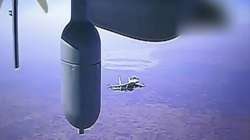Russian fighter jet strikes American drone flying over Syria; second incident in 24 hours
At least two U.S. officials have confirmed that the strike damaged a MQ-9 Reaper drone.

The White House informed that another U.S. drone flying over Syrian airspace was shot down on Wednesday by Russian fighter jets, making this the sixth such incident in a month and the second in the past 24 hours. Meanwhile, US has accused the Russian forces of flying warplanes dangerously close to American manned and unmanned aircraft, putting crews and the planes at risk and raising questions as to what the U.S. may need to do in response.
Atleast, two U.S. officials have confirmed that the strike damaged a MQ-9 Reaper drone. The officials were not authorized to publicly discuss the matter and spoke on condition of anonymity.
"We've seen the reports, the early reports, of a second Russian fighter aircraft this week flying dangerously close to our drone" on a mission to counter Islamic State militants in Syria, White House press secretary Karine Jean-Pierre said. She did not provide other details, but said Russia's “close approach to and deployment of flares over U.S. drones during a routine mission” violates international norms.
In the incidents over the past two days, Russian warplanes have fired flares that struck U.S. MQ-9 Reaper drones. On Tuesday, the flares damaged a drone's propeller; on Wednesday, Russian-dropped flares hit a drone. In previous incidents, Russian jets have intercepted the U.S. planes at dangerously close distances, including one instance with a manned aircraft that the U.S. said put the lives of the four American crewmembers at risk.
Experts say Russia is likely conducting the harassing attacks to support Iran's goal of ousting U.S. forces from Syria, with a senior U.S. defense official saying Iran wants to be able to more easily move lethal aid to Lebanese Hezbollah and threaten Israel. Russia relies on Iran's support for the Kremlin's war operations in Ukraine.
Toward that end, the U.S. has seen more cooperation, collaboration, planning and intelligence sharing, largely between mid-level Russian and Iranian Quds force leaders in Syria, according to the U.S. defense official, who spoke on condition of anonymity to discuss ongoing military missions. John Hardie, director of the Russia program for the Foundation for Defense of Democracies, said the intercepts are part of a coordinated effort by Russia and Iran “to try to push the U.S. out of Syria, just kind of build pressure over time, in the hopes that Washington will eventually withdraw.”
But the intercepts raise questions as to how the U.S. will respond and whether the risk of a larger confrontation is increasing. “It doesn't seem like the Russians really want a direct, hot confrontation, but things that are sort of below that threshold, like messing with our drones, is right up their alley," Hardie said. He suggested that one option may be similar to how the U.S. responded after a Black Sea incident near Crimea, where a Russian jet collided with a U.S. drone. The U.S. relocated its patrols to avoid getting into a direct conflict.
Both the U.S. and Russia are conducting missions in Syria. Russia backs the government of Syrian leader Bashar al-Assad. The U.S. is working with the Kurdish-backed Syrian Democratic Forces in operations against IS extremists. The SDF is in a civil war with Assad.
ALSO READ | North Korea's Kim Jong Un meets Russian Defence Minister Sergei Shoigu in Pyongyang: Report
ALSO READ | Russian President Vladimir Putin signs law banning 'gender reassignment surgery' | DETAILS